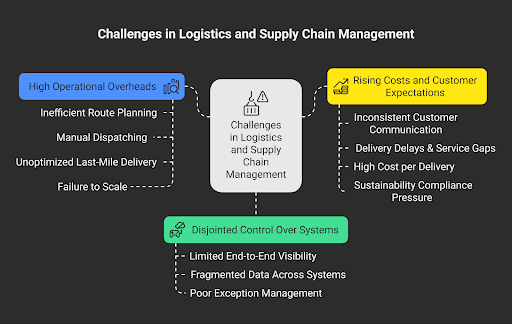- Logistics
Achieve Faster and Smarter Deliveries with Shipping Logistics Software
Table of Contents
- Common Delivery Challenges Slowing Down Your Supply Chain
- Why do modern logistics need modern Shipping Logistics Software?
- How FarEye as an AI-native solution stands out
- Case in Point: How FarEye Optimizes Complex Logistics Networks
- The Strategic Path Forward for Smarter Deliveries
- Frequently Asked Questions

Rapid, smart deliveries are no longer just an expectation, they're the cornerstone of logistics success in this digital age. Manual operations and legacy systems can't support today's level of complexity, where real-time visibility, dynamic routing, and predictive accuracy determine market leaders.
Shipping logistics software that use Artificial intelligence and machine learning are improving operations by removing blind spots, anticipating delays before they occur, and constantly streamlining delivery performance. Businesses that are still working on static models are falling behind in profitability as well as customer retention.
Studies show logistics operations that integrate AI-based platforms improve delivery accuracy by as much as 30% and reduce operational expenses by a huge margin. In a competitive marketplace moving at a digital pace, remaining reactive is a disadvantage.
Read on to understand the shared delivery challenges holding companies back and the reasons why intelligent logistics software based on AI and machine learning is the only way forward.
Must Knows:
- Shipping logistics software is designed to automate deliveries and improve shipment visibility.
- FarEye enables businesses to manage carrier networks and reduce delivery delays efficiently.
- AI-native logistics software helps organizations scale multi-region delivery operations faster.
- Modern logistics platforms integrate ERP, WMS, and CRM systems into one unified workflow.
Common Delivery Challenges Slowing Down Your Supply Chain
Logistics leaders today are facing problems like fragmented visibility, rising transportation costs, outdated systems, and unpredictable customer demands.
Without strong infrastructure, delays occur, costs increase, and service expectations are harder to meet. To stay competitive, it is important to fix the barriers slowing your supply chain.
Here’s a breakdown of the common delivery challenges you might be facing today:

Lack of centralized oversight
- Limited End-to-End Shipment Visibility
Partial or outdated shipment information reduces your ability to manage deliveries proactively. When your teams rely on delayed updates, they operate in reaction mode, with no control. Disruptions often surface too late, damaging schedules, customer expectations, and overall network reliability.
- Fragmented Data Across Systems
Disconnected systems across warehouses, transportation, and order management make information flow unreliable. Each missing update or manual data transfer creates risk points. Over time, these inefficiencies compound and slow the overall movement of goods across your network.
- Poor Exception Management
Delivery disruptions are part of logistics, but slow escalation can turn small issues into bigger problems. When failures go undetected, your teams face downstream delays, rising costs, and lost customer confidence. Addressing disruptions early helps protect operational flow and maintain service consistency across your network.
High operational overheads
- Inefficient Route Planning
When routes are planned without real-time inputs, you lose flexibility where it matters most. Traffic changes, weather disruptions, or last-minute delivery adjustments turn static plans into costly liabilities. Over time, the gap between planned and actual execution grows wider, pulling down service levels and raising operational costs.
- Manual Dispatching and Allocation
In fast-moving environments, manual dispatching quickly becomes a limiting factor. Driver assignments, load balancing, and task prioritization are harder to control when teams rely on spreadsheets and disconnected systems. As delivery volumes rise, so do missed opportunities and resource wastage.
- Unoptimized Last-Mile Delivery
The last mile is where operations and customer experience are most exposed. Without dynamic routing and flexible time windows, even well-planned deliveries break down under shifting realities. Every failed first attempt drives up costs and eats into margins you cannot afford to lose.
- Failure to Scale During Peak Demand
Higher order volumes during holidays and peak seasons test the limits of logistics systems. Networks built on legacy systems often miss delivery targets, increase overtime costs, and lose operational stability when demand surges.
Rising costs and customer expectations
- Inconsistent Customer Communication
Today’s customers expect visibility from the cart to the doorstep. As a result, communication gaps create frustration, increase customer service costs, and damage your brand’s reputation at the most critical moment.
- Delivery Delays and Service Gaps
Late deliveries and missed service promises quickly break customer trust. Each delay adds frustration, increases support costs, and risks losing future business. Consistently delivering on time is key to keeping customers loyal and protecting your brand reputation.
- High Cost per Delivery
If deliveries are planned inefficiently or executed poorly, your cost-per-shipment skyrockets. In a margin-thin logistics industry, every extra mile or missed delivery window directly impacts profitability.
- Increasing Pressure due to Sustainability Compliance
As you know, environmental regulations are getting strict, and expectations for sustainable operations are increasing, logistics networks face pressure to control emissions. However, inefficient routing and missed consolidation opportunities make it harder to meet sustainability goals without compromising cost and service commitments.
Why do modern logistics need modern Shipping Logistics Software?
AI-powered shipping logistics software address modern delivery problems by providing you with real-time visibility, predictive planning, and automated execution across the supply chain. These technologies allow supply chains to act faster, plan smarter, and scale more reliably.
Here is how the right platform strengthens daily operations and supports long-term scalability:
Route Optimization
Traffic patterns and operational conditions fluctuate continuously. Companies dependent on static routing frameworks usually face delays and service disruptions. AI-driven shipping logistics software helps find the optimal delivery paths based on live traffic, weather patterns, and order volume fluctuations.
You can take FarEye as an example where machine learning helps networks maintain flexibility without sacrificing efficiency.


Real-Time Tracking and Predictive ETA Updates
Routing optimization creates faster paths, but without comprehensive visibility, risks may still escalate. Shipping and logistics software combines live tracking with predictive ETA algorithms. It lets your team predict service disruptions before they become catastrophic. This allows decision-makers to manage exceptions proactively, safeguard SLAs, and protect the customer experience.
Automated Dispatching and Order Batching
As order volumes increase, manual dispatching quickly becomes a critical operational bottleneck. With shipping software solutions, you can automate driver assignment, batching, fleet load balancing, and reduce the risk of resource underutilization.
By shifting to automated workflows, organizations preserve delivery speed, improve fleet efficiency, and ensure faster decision-making.
Predictive Delivery Risk Management
Unplanned disruptions are inevitable in logistics operations. And AI-native logistics software with predictive analytics identifies potential delays based on real-time patterns and historical data.
It enables teams to take corrective action early. Also, it helps you to minimize service disturbances and cost increases before they impact customer commitments or operational efficiency.
Seamless Integration Across Systems
Visibility gaps and delays happen when systems don't work together. So, when you use shipping logistics software, it connects ERP, WMS, CRM, and e-commerce operations into a single workflow.
This integration brings order to your inventory management, order processing, and carrier coordination. It also enhances customer communications, giving logistics leaders full operational control without relying on fragmented manual processes.
How FarEye as an AI-native solution stands out
Choosing logistics technology is a decision that defines how your business will grow and compete. FarEye is designed with AI at its foundation, not as an afterthought or an extension. It helps logistics leaders control complexity, adapt to market shifts, and reduce operational costs consistently.


Here are the reasons why FarEye is the right solution for your business:
Dynamic Route Planning
FarEye optimizes routes dynamically based on live traffic, order changes, and driver availability. As conditions shift throughout the day, routes are recalculated automatically to maintain delivery precision. If your company is aiming to increase fleet efficiency and lower fuel costs then you will find FarEye's dynamic routing critical.
AI-Native Platform
FarEye is built on an AI-native architecture, not retrofitted with artificial intelligence later. It enables real-time route optimization, dynamic scheduling, and predictive risk management as standard capabilities. FarEye is the right choice if your teams need operational control beyond static planning models.
API Integrations with Marketplaces, Carriers & WMS/ERP
FarEye offers robust integration with ERP, WMS, TMS, CRM, and e-commerce platforms. These integrations synchronize inventory, orders, carriers, and customer data into a unified control system. FarEye becomes essential if you want to eliminate manual processes and accelerate order-to-delivery cycles across regions and fulfillment models.
Predictive Delivery Analytics
FarEye uses predictive delivery analytics to anticipate delays and recommend corrective actions. Its AI models detect traffic slowdowns, carrier bottlenecks, weather risks, and operational gaps in advance.
For organizations seeking earlier risk intervention, FarEye’s proactive intelligence will strengthen your service reliability while protecting operating margins from unexpected cost hikes.
Scalable Architecture
FarEye’s infrastructure is designed to support expansion without disrupting existing logistics frameworks. Organizations scaling into new regions or launching new fulfillment models find the platform easily adapts.
If you’re looking to build a multi-region logistic network, then FarEye offers the scaleable architecture for you to grow without operational compromise.
Customizable Workflows
FarEye allows low-code customization of workflows to match specific industry and delivery needs. Companies can configure scheduling logic, routing rules, customer communication triggers, and driver management processes. FarEye gives logistics leaders the agility to evolve faster than market demands without technical slowdowns.
Enhanced Customer Experience
FarEye improves the customer experience through real-time visibility and proactive notifications. Customers can track shipments, receive ETA updates, and manage delivery preferences dynamically. Also, for a better customer experience, FarEye’s real-time visibility reduces failed delivery attempts and strengthens trust across the last-mile delivery process.
Case in Point: How FarEye Optimizes Complex Logistics Networks
An American manufacturer emerged as a key market player with smart delivery management
Facing low shipment visibility, rigid delivery windows, and customer dissatisfaction, an American cabinet manufacturer turned to FarEye. FarEye introduced real-time tracking, flexible delivery scheduling, and feedback loops to improve service control.
As a result, delivery success rose to 73%, OTIF performance increased by 16%, and customer satisfaction climbed 34 NPS points.
An African retailer achieved operational excellence with FarEye solutions
Africa’s largest retailer struggled with fragmented carrier operations and delayed fulfillment. FarEye deployed a centralized parcel management system with dynamic carrier routing and real-time order-to-door tracking.
Delivery times improved by 15%, Net Promoter Scores rose by 15 points, and first-time delivery success became a market benchmark.
The Strategic Path Forward for Smarter Deliveries
Nowadays, managing deliveries demands more than steady routing and disconnected carrier operations. That’s where shipping logistics software comes into play. It gives you control over delivery execution, shipment visibility, and customer communications. Choosing the right tool keeps your deliveries reliable and runs your operations efficiently.
If you’re looking for smarter, faster deliveries, FarEye is the best fit for you. Its AI-driven shipping logistics software reduces delays, increases shipment visibility, and improves first-attempt delivery success.
Ready to elevate your delivery operations? Talk to Us and see how FarEye can help.
Frequently Asked Questions
What’s the Average Setup Time?
The average setup time for shipping logistics software depends on system complexity. AI-native platforms like FarEye are designed for quick setup (i.e. within 8 to 12 weeks). If your teams use existing APIs and templates, you can often achieve faster go-live timelines.
Can I Integrate FarEye with ERP or WMS?
Yes, FarEye integrates easily with ERP, WMS, CRM, and other carrier platforms. It uses an API-first design that connects your inventory, orders, and delivery operations. Ultimately, this helps your team maintain real-time visibility without obstructing existing systems or workflows.
How to Choose the Best Logistics Software Company?
To choose the best logistics software company, start by evaluating flexibility, visibility, and integration strength. It’s a necessity to look for AI-native platforms like FarEye which offer predictive analytics and low-code workflow options. Such an approach ensures your business can scale faster and operate efficiently across complex delivery environments.
Can Shipping Logistics Software Boost My On-Time Deliveries?
Yes, shipping logistics software helps businesses deliver on time across different regions. Real-time route optimization keeps shipments moving and reduces unexpected delivery delays. It results in faster deliveries, fewer missed SLAs, and better customer experiences.
Can Logistics Software Help Me Scale My Delivery Operations?
Logistics software helps businesses grow deliveries into new areas and handle more orders smoothly. AI-powered platforms manage higher shipment volumes, fleet changes, and rising customer demands. They clear the manual slowdowns that make scaling deliveries harder.

Komal Puri is a seasoned professional in the logistics and supply chain industry. As the AVP of Marketing and a subject matter expert at FarEye, she has been instrumental in shaping the industry narrative for the past decade. Her expertise and insights have earned her numerous awards and recognition. Komal’s writings reflect her deep understanding of the industry, offering valuable insights and thought leadership.
Let's Talk to Our Experts and Optimize Your Deliveries Today!
An expert from our team will reach out within 24 hours

